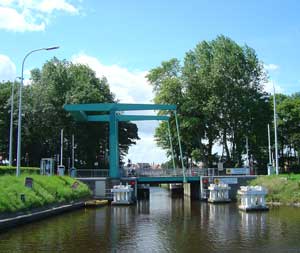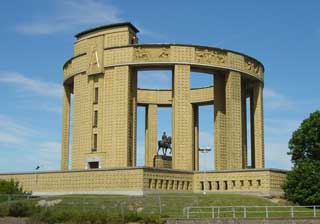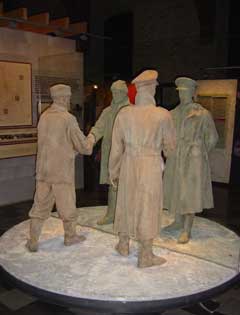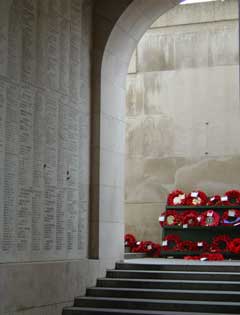Oudenburg to Veurne
Tuesday 19th July
 Today's
cruise took us west along the Plassendale-Nieuwpoort canal, inland of
what was once the 'Ter Streep' sandbank, of which Oostende formed
the eastern extremity. A series of lifting bridges were operated by a
mobile bridge keeper whose erratic behaviour veered from inexplicable
delays to opening the bridge before we'd even arrived. Our route to Veurne
took us through the sea-locks at Nieuwpoort which operate three hours
either side of high water, and by happy coincidence we had arrived bang
on high water. Even so, we needed the phone numbers in our Flanders waterways
guide in order to contact the lock-keepers who seemd rather reluctant
to keep a look out for customers.
Today's
cruise took us west along the Plassendale-Nieuwpoort canal, inland of
what was once the 'Ter Streep' sandbank, of which Oostende formed
the eastern extremity. A series of lifting bridges were operated by a
mobile bridge keeper whose erratic behaviour veered from inexplicable
delays to opening the bridge before we'd even arrived. Our route to Veurne
took us through the sea-locks at Nieuwpoort which operate three hours
either side of high water, and by happy coincidence we had arrived bang
on high water. Even so, we needed the phone numbers in our Flanders waterways
guide in order to contact the lock-keepers who seemd rather reluctant
to keep a look out for customers.
 A
further delay in Nieuwpoort's tidal basin gave us time to admire the memorial
to Albert I, chief of the Belgian Army at the time of the Great War and
instigator of the successful plan to hold back the advancing Germans by
flooding the polders - achieved by opening the lock gates at high water.
A
further delay in Nieuwpoort's tidal basin gave us time to admire the memorial
to Albert I, chief of the Belgian Army at the time of the Great War and
instigator of the successful plan to hold back the advancing Germans by
flooding the polders - achieved by opening the lock gates at high water.
We also had time to dismantle our canopy in readiness for the 5 metre bridges on the Nieuwpoort-Dunkirk canal which at least meant an unhindered passage as far as Veurne. Here the advertised 4.7 metre railbridge was only 4.7 metres in the open position, which we achieved using the reporting telephone provided. Similarly the main town bridge, advertised as 5 metres, was preceded by a lift bridge which we eventually persuaded the harbour master to open. The Nieuwpoortsluis provided our final obstacle, as although it stands open, it features an unmarked swinging bridge which must be operated by hand. The arrival of the harbour master to operate the bridge gave him chance to allocate us a berth in the well-equipped and again, free, yachthaven where we made use of our 32A power lead to plug into the over-specified electricity sockets.
 After
an afternoon spent enjoying cafe society and Belgian waffles in Veurne's
traditional market square, we had allocated the next day to make the 50
minute bus journey to Ieper (Ypres) to learn more about the town's involvement
in the Great War. The award-winning In
Flanders Fields museum in the old Lakenhallen is a multi-media
presentation of Ieper before, during and after the conflict which gaves
a very graphic insight into what life was like. With 137 cemeteries in
the surrounding countryside you are never far from a reminder of that
turbulent time, and we made a pilgrimage to the Ramparts cemetery before
enjoying the more peaceful view from the ramparts walk.
After
an afternoon spent enjoying cafe society and Belgian waffles in Veurne's
traditional market square, we had allocated the next day to make the 50
minute bus journey to Ieper (Ypres) to learn more about the town's involvement
in the Great War. The award-winning In
Flanders Fields museum in the old Lakenhallen is a multi-media
presentation of Ieper before, during and after the conflict which gaves
a very graphic insight into what life was like. With 137 cemeteries in
the surrounding countryside you are never far from a reminder of that
turbulent time, and we made a pilgrimage to the Ramparts cemetery before
enjoying the more peaceful view from the ramparts walk.
 One
of the city gates, the Meninpoort was rebuilt after the war as a monument
to the 100,000 combatants with no known grave and 55,000 are named on
the gate. The Last Post has been sounded daily since 1928, except during
the German occupation in the Second World War, as a tribute to those lost.
One
of the city gates, the Meninpoort was rebuilt after the war as a monument
to the 100,000 combatants with no known grave and 55,000 are named on
the gate. The Last Post has been sounded daily since 1928, except during
the German occupation in the Second World War, as a tribute to those lost.
Cruising Statistics
Distance: 16 nm
Total to date: 1560 nm
Avg Speed: 4.5 knots
Duration: 5:15 hours
Diesel: 18 litres
Mooring: Free
Electricity: €2.50/10kWh (32A)
Water: None
Locks
Graven
Veurne
Nieuwpoort (open)
Bridges
Zandvoorde
(lift)
Gistel (lift)
Snaaskerke foot (6.5m)
Snaaskerke (5.25m)
Leffinge (lift)
Slijpe (lift)
Rattevalle (lift)
Gravensas (lift)
Veurnesas (lift)
Oude spoorweg (5m)
Pelikaan (5m)
Zelte (8m)
Wulpen foot (5m)
Nieuwe Wulpen (9m)
Foot (5m)
Spoorweg (4.7m open)
Nieuwpoort (lift)
Nieuwpoort
foot (5m)
Nieuwpoortsluis (swing)
Charts
Toeristische Vaargids West & Oost Vlaanderen
Navicarte 23
Geocart 1 & 4